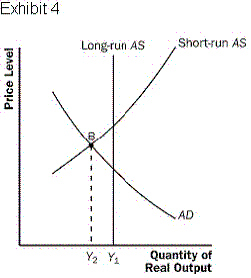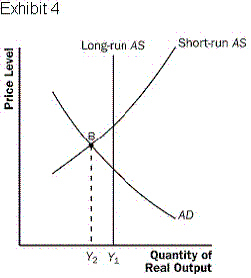True/False
Indicate whether the
statement is true or false.
|
|
|
1.
|
Over the last 50 years, UK real GDP has grown at about 5 per cent per
year.
|
|
|
2.
|
Investment is a particularly volatile component of spending across the business
cycle.
|
|
|
3.
|
An increase in price expectations shifts the long-run aggregate supply curve to
the left.
|
|
|
4.
|
If the classical dichotomy and monetary neutrality hold in the long run, then
the long-run aggregate supply curve should be vertical.
|
|
|
5.
|
Economists refer to fluctuations in output as the "business cycle"
because movements in output are regular and predictable.
|
|
|
6.
|
One reason aggregate demand slopes downward is the wealth effect: a decrease in
the price level increases the value of money holdings and consumer spending rises.
|
|
|
7.
|
If a country’s central bank increases the money supply, the aggregate
demand curve shifts to the left.
|
|
|
8.
|
The misperceptions theory explains why the long-run aggregate supply curve is
downward sloping.
|
|
|
9.
|
A rise in price expectations that causes wages to rise causes the short-run
aggregate supply curve to shift left.
|
|
|
10.
|
If the economy is in a recession, the economy will adjust to long-run
equilibrium on its own as wages and price expectations rise.
|
|
|
11.
|
In the short run, if the government cuts back spending to balance its budget, it
will probably cause a recession.
|
|
|
12.
|
The short-run effect of an increase in aggregate demand is an increase in output
and an increase in the price level.
|
|
|
13.
|
A rise in the price of oil tends to cause stagflation.
|
|
|
14.
|
In the long run, an increase in government spending tends to increase output and
prices.
|
|
|
15.
|
If policy makers choose to try to move the economy out of a recession, they
should use their policy tools to decrease aggregate demand.
|
Multiple Choice
Identify the
choice that best completes the statement or answers the question.
|
|
|
16.
|
Which of the following statements about economic fluctuations is true?
a. | None of these answers | b. | A depression is a mild
recession. | c. | A variety of spending, income, and output measures can be used to measure economic
fluctuations because most macroeconomic quantities tend to fluctuate together. | d. | A recession is when
output rises above the natural rate of output. | e. | Economic fluctuations have been termed the
"business cycle" because the movements in output are regular and
predictable. |
|
|
|
17.
|
According to the interest rate effect, aggregate demand slopes downward
(negatively) because lower prices
a. | increase money holdings, decrease lending, interest rates rise, and investment
spending falls. | b. | increase the value of money holdings and consumer spending
increases. | c. | decrease the value of money holdings and consumer spending
decreases. | d. | reduce money holdings, increase lending, interest rates fall, and investment spending
increases. |
|
|
|
18.
|
Which of the following would not cause a shift in the long-run aggregate supply
curve? An increase in:
a. | the available capital | c. | the available technology | b. | the available
labour | d. | price
expectations |
|
|
|
19.
|
Which of the following is not a reason why the aggregate demand curve slopes
downward?
a. | The exchange-rate effect | b. | The wealth effect. | c. | The classical
dichotomy/monetary neutrality effects. | d. | The interest-rate effect | e. | All of these answers
are reasons why the aggregate-demand curve slopes downward. |
|
|
|
20.
|
In the model of aggregate demand and aggregate supply, the initial impact of an
increase in consumer optimism is to shift the
a. | short-run aggregate supply curve to the left. | b. | aggregate demand
curve to the right. | c. | short-run aggregate supply curve to the
right. | d. | aggregate demand curve to the left. | e. | long-run aggregate supply curve to the
left. |
|
|
|
21.
|
Which of the following statements is true regarding the long-run aggregate
supply curve? The long-run aggregate supply curve
a. | is vertical because an equal change in all prices and wages leaves output
unaffected. | b. | is positively sloped because price expectations and wages tend to be fixed in the
long run. | c. | shifts right when the government raises the minimum wage. | d. | shifts left when the
natural rate of unemployment falls. |
|
|
|
22.
|
According to the wealth effect, aggregate demand slopes downward (negatively)
because lower prices
a. | increase the value of money holdings and consumer spending
increases. | b. | decrease the value of money holdings and consumer spending
decreases. | c. | reduce money holdings, increase lending, interest rates fall, and investment spending
increases. | d. | increase money holdings, decrease lending, interest rates rise, and investment
spending falls. |
|
|
|
23.
|
The natural rate of output is the amount of real GDP produced when
a. | the economy is at the natural rate of unemployment. | b. | the economy is at
the natural rate of investment. | c. | the economy is at the natural rate of aggregate
demand. | d. | there is no unemployment. |
|
|
|
24.
|
Suppose the price level falls but because of fixed nominal wage contracts, the
real wage rises and firms cut back on production. This is a demonstration of the
a. | sticky-wage theory of the short-run aggregate supply curve. | b. | classical dichotomy
theory of the short-run aggregate supply curve. | c. | misperceptions theory of the short-run
aggregate supply curve. | d. | sticky-price theory of the short-run aggregate
supply curve. |
|
|
|
25.
|
Suppose the price level falls but suppliers only notice that the price of their
particular product has fallen. Thinking there has been a fall in the relative price of their product,
they cut back on production. This is a demonstration of the
a. | misperceptions theory of the short-run aggregate supply curve. | b. | classical dichotomy
theory of the short-run aggregate supply curve. | c. | sticky-price theory of the short-run aggregate
supply curve. | d. | sticky-wage theory of the short-run aggregate supply
curve. |
|
|
|
26.
|
Suppose the economy is initially in long-run equilibrium. Then suppose there is
an increase in military spending due to rising international tensions. According to the model of
aggregate demand and aggregate supply, what happens to prices and output in the short run?
a. | Prices fall; output rises. | c. | Prices rise; output
falls. | b. | Prices fall; output falls. | d. | Prices rise; output rises. |
|
|
|
27.
|
Suppose the economy is initially in long-run equilibrium. Then suppose there is
an increase in military spending due to rising international tensions. According to the model of
aggregate demand and aggregate supply, what happens to prices and output in the long run?
a. | Output falls; prices are unchanged from the initial value. | b. | Prices fall; output
is unchanged from its initial value. | c. | Output and the price level are unchanged from
their initial values. | d. | Prices rise; output is unchanged from its
initial value. | e. | Output rises; prices are unchanged from the initial
value. |
|
|
|
28.
|
Suppose the economy is initially in long-run equilibrium. Then suppose there is
a drought that destroys much of the wheat crop. According to the model of aggregate demand and
aggregate supply, what happens to prices and output in the short run?
a. | Prices rise; output falls. | c. | Prices rise; output
rises. | b. | Prices fall; output rises. | d. | Prices fall; output falls. |
|
|
|
29.
|
Suppose the economy is initially in long-run equilibrium. Then suppose there is
a drought that destroys much of the wheat crop. If policymakers allow the economy to adjust to
long-run equilibrium on its own, according to the model of aggregate demand and aggregate supply,
what happens to prices and output in the long run?
a. | Output rises; prices are unchanged from the initial value. | b. | Output and the price
level are unchanged from their initial values. | c. | Output falls; prices are unchanged from the
initial value. | d. | Prices fall; output is unchanged from its initial value. | e. | Prices rise; output
is unchanged from its initial value. |
|
|
|
30.
|
Stagflation occurs when the economy experiences
a. | rising prices and rising output. | c. | falling prices and falling
output. | b. | rising prices and falling output. | d. | falling prices and rising
output. |
|
|
|
31.
|
Which of the following events shifts the short-run aggregate supply curve to the
right?
a. | a decrease in the money supply | b. | a drop in oil prices | c. | an increase in
government spending on military equipment | d. | none of these answers | e. | an increase in price
expectations |
|
|
|
32.
|
Refer to Exhibit 4. Suppose the economy is operating in a recession such as
point B in Exhibit 4. If policymakers wished to move output to its long-run natural rate, they should
attempt to shift  a. | aggregate demand to the left. | c. | aggregate demand to the
right. | b. | short-run aggregate supply to the left. | d. | short-run aggregate supply to the
right. |
|
|
|
33.
|
Refer to Exhibit 4. Suppose the economy is operating in a recession such as
point B in Exhibit 4. If policymakers allow the economy to adjust to the long-run natural rate on its
own, people will  a. | reduce their price expectations and the short-run aggregate supply will shift
right. | b. | raise their price expectations and aggregate demand will shift
left. | c. | raise their price expectations and the short-run aggregate supply will shift
left. | d. | reduce their price expectations and aggregate demand will shift
right. |
|
|
|
34.
|
According to the model of aggregate supply and aggregate demand, in the long
run, an increase in the money supply should cause prices to
a. | rise and output to rise. | c. | fall and output to
fall. | b. | fall and output to remain unchanged. | d. | rise and output to remain
unchanged. |
|
|
|
35.
|
Policy makers are said to "accommodate" an adverse supply shock if
they
a. | fail to respond to the adverse supply shock and allow the economy to adjust on its
own. | b. | respond to the adverse supply shock by decreasing aggregate demand, which lowers
prices. | c. | respond to the adverse supply shock by decreasing short-run aggregate
supply. | d. | respond to the adverse supply shock by increasing aggregate demand, which further
raises prices. |
|